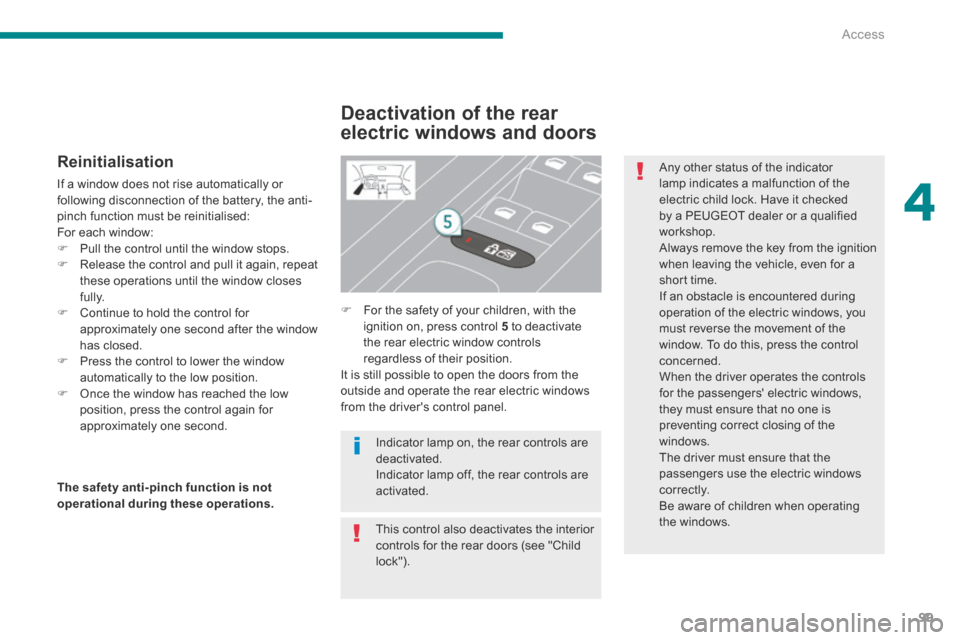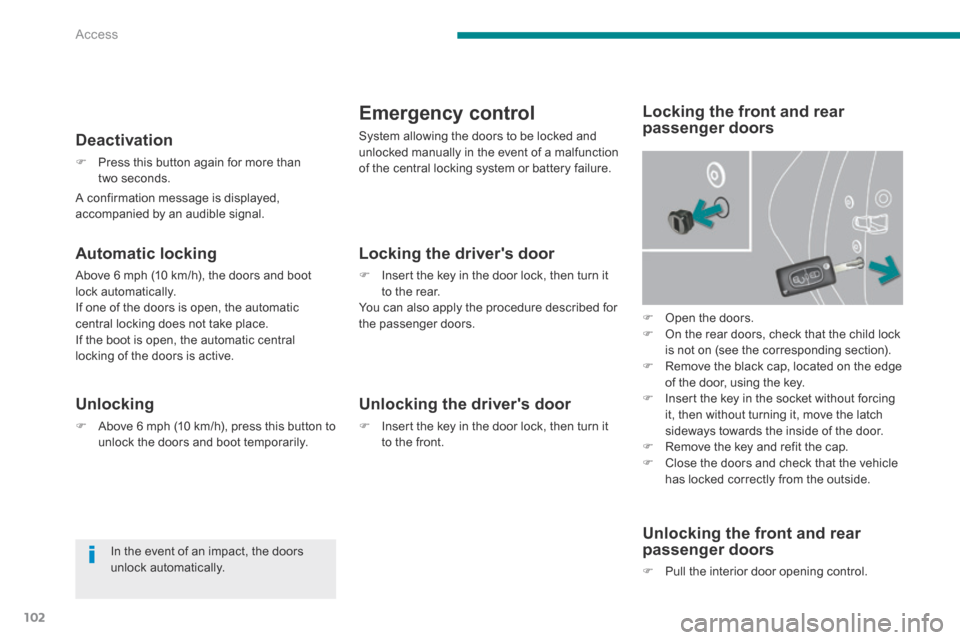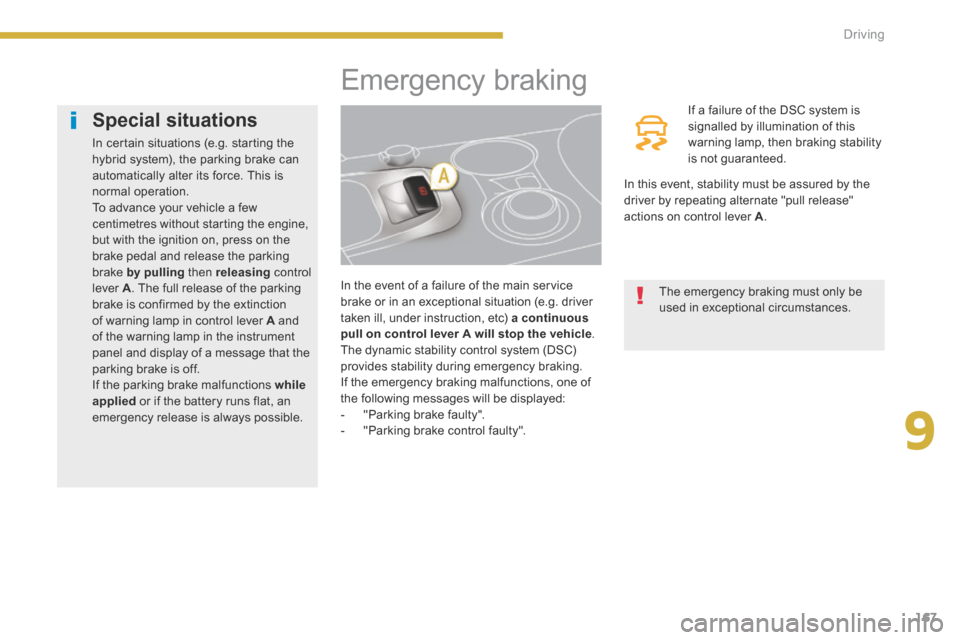Page 101 of 378

4
Access99
Reinitialisation
If a window does not rise automatically or following disconnection of the battery, the anti-pinch function must be reinitialised:
For each window: Pull the control until the window stops. Release the control and pull it again, repeat these operations until the window closes fully. Continue to hold the control for approximately one second after the window has closed. Press the control to lower the window automatically to the low position. Once the window has reached the low position, press the control again for approximately one second.
Deactivation of the rear
electric windows and doors
For the safety of your children, with the ignition on, press control 5 to deactivate the rear electric window controls regardless of their position. It is still possible to open the doors from the outside and operate the rear electric windows from the driver's control panel.
The safety anti-pinch function is not operational during these operations.
This control also deactivates the interior controls for the rear doors (see "Child lock").
Indicator lamp on, the rear controls are deactivated. Indicator lamp off, the rear controls are activated.
Any other status of the indicator lamp indicates a malfunction of the electric child lock. Have it checked by a PEUGEOT dealer or a qualified workshop. Always remove the key from the ignition when leaving the vehicle, even for a short time. If an obstacle is encountered during operation of the electric windows, you must reverse the movement of the window. To do this, press the control concerned. When the driver operates the controls for the passengers' electric windows, they must ensure that no one is preventing correct closing of the windows. The driver must ensure that the passengers use the electric windows c o r r e c t l y. Be aware of children when operating the windows.
Page 104 of 378

Access
102
A confirmation message is displayed, accompanied by an audible signal.
Deactivation
Press this button again for more than two seconds.
Unlocking
Above 6 mph (10 km/h), press this button to unlock the doors and boot temporarily.
Emergency control
System allowing the doors to be locked and unlocked manually in the event of a malfunction of the central locking system or battery failure.
Open the doors. On the rear doors, check that the child lock is not on (see the corresponding section). Remove the black cap, located on the edge of the door, using the key. Insert the key in the socket without forcing it, then without turning it, move the latch sideways towards the inside of the door. Remove the key and refit the cap. Close the doors and check that the vehicle has locked correctly from the outside.
Locking the driver's door
Insert the key in the door lock, then turn it to the rear. You can also apply the procedure described for the passenger doors.
Unlocking the driver's door
Insert the key in the door lock, then turn it to the front.
Locking the front and rear passenger doors
Unlocking the front and rear passenger doors
Pull the interior door opening control.
In the event of an impact, the doors unlock automatically.
Automatic locking
Above 6 mph (10 km/h), the doors and boot lock automatically. If one of the doors is open, the automatic central locking does not take place. If the boot is open, the automatic central locking of the doors is active.
Page 106 of 378
Access
104
Lower tailgate
Opening Closing
Push the handle C to the right and tilt the tailgate D g e nt l y. Raise the tailgate D , push it fully to close it, check that it is secured correctly.
Before opening the boot, ensure that there is nothing or anyone within the opening radius. For reasons of safety, correct operation and compliance with regulations, do not drive with the boot and the lower tailgate open. If the battery is disconnected, the boot cannot be opened. Do not climb onto the lower tailgate and do not subject it to heavy knocks, it may be damaged. Always close the lower tailgate and check that it is secured correctly before closing the boot. When closing the lower tailgate, ensure that no person or object is in the proximity of the moving parts to avoid any risk of injury or damage.
Do not open the lower tailgate when a towbar is fitted.
Maximum authorised weight on the lower tailgate when open: 200 kg .
Page 169 of 378

9
167
Driving
Emergency braking
In the event of a failure of the main service brake or in an exceptional situation (e.g. driver taken ill, under instruction, etc) a continuous pull on control lever pull on control lever pull on control leverA will stop the vehicle . The dynamic stability control system (DSC) provides stability during emergency braking. If the emergency braking malfunctions, one of the following messages will be displayed: - "Parking brake faulty". - "Parking brake control faulty".
If a failure of the DSC system is signalled by illumination of this warning lamp, then braking stability is not guaranteed.
In this event, stability must be assured by the driver by repeating alternate "pull release" actions on control lever A .
The emergency braking must only be used in exceptional circumstances.
Special situations
In certain situations (e.g. starting the hybrid system), the parking brake can automatically alter its force. This is normal operation. To advance your vehicle a few centimetres without starting the engine, but with the ignition on, press on the brake pedal and release the parking brake by pulling then releasing control lever A . The full release of the parking brake is confirmed by the extinction of warning lamp in control lever A and of the warning lamp in the instrument panel and display of a message that the parking brake is off. If the parking brake malfunctions while applied or if the battery runs flat, an emergency release is always possible.
Page 172 of 378
170Driving
Situations Consequences
Display of the message " Parking brake control fault - auto parking brake activated " and of the following warning lamps:
- Only the automatic application on switching off the engine and automatic release on acceleration functions are available. - The manual application/release of the electric parking brake and the emergency braking are not available.
and possibly
flashing
Battery fault - If the battery warning lamp comes on you must stop immediately as soon as the traffic allows. Stop and immobilise your vehicle (if necessary, place the two chocks under the wheels). - Apply the electric parking brake before switching off the engine.
Page 193 of 378
10
Checks191
Diesel engine
The various caps and covers allow access for checking the levels of the various fluids, for replacing certain components and for priming the fuel system.
1. Power steering reservoir. 2. Screenwash and headlamp wash reservoir. 3. Coolant reservoir.
4. Brake fluid reservoir.
5. Battery / Fuses. 6. Fusebox. 7. Air filter.
8. Engine oil dipstick.
9. Engine oil filler cap. 10. Priming pump. 11. Bleed screw.
Page 197 of 378

10
Checks195
Checks
Unless otherwise indicated, check these components in accordance with the warranty and maintenance record and according to your engine. Other wise, have them checked by a PEUGEOT dealer or a qualified workshop.
The battery does not require any maintenance. However, check that the terminals are clean and correctly tightened, particularly in summer and winter. When carrying out work on the battery, refer to the "12 V battery" section for details of the precautions to be taken before disconnecting the battery and following its reconnection.
12 V battery
Air filter and passenger compartment filter
Refer to the warranty and maintenance record for details of the replacement intervals for these components. Depending on the environment (e.g. dusty atmosphere) and the use of the vehicle (e.g. city driving), replace them twice as often if necessar y . replace them twice as often if necessar y . replace them twice as often if necessar y A clogged passenger compartment filter may have an adverse effect on the per formance of the air conditioning system and generate undesirable odours.
Oil filter
Replace the oil filter each time the engine oil is changed. Refer to the warranty and maintenance record for details of the replacement interval for this component.
Particle emission filter (Diesel)
The start of saturation of the particle filter is indicated by the temporary illumination of this warning lamp accompanied by a message in the multi-function screen. As soon as the traffic conditions permit, regenerate the filter by driving at a speed of at least 40 mph (60 km/h) until the warning lamp goes off. If the warning lamp stays on, this indicates a low additive level.
On a new vehicle, the first particle filter regeneration operations may be accompanied by a "burning" smell, which is per fectly normal. Following prolonged operation of the vehicle at very low speed or at idle, you may, in exceptional circumstances, notice the emission of water vapour at the exhaust on acceleration. This does not affect the behaviour of the vehicle or the environment.
The 100% electric mode is not available during regeneration of the particle emissions filter.
Before doing anything under the bonnet, switch off the ignition ( Readylamp off) to avoid any risk of injury resulting from automatic operation of the engine.
Page 217 of 378
11
Practical information215
Dashboard fuses Fuse tables
The fusebox is placed in the lower dashboard.
Fuse N° Rating (A) Functions
F115 Rear wiper.
F2- Not used.
F35 Airbag control unit.
F410 Electrochrome rear view mirror, air conditioning, switching and protection unit, rear multimedia, traction battery control unit.
F530 Front one-touch electric windows.
F630 Rear one-touch electric windows.
F75 Front and rear courtesy lamps, map reading lamps, rear reading lamps, sun visor lighting, glove box lighting, centre armrest lighting, boot 12 V relay control.